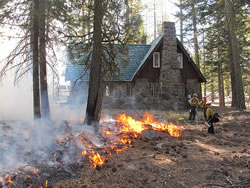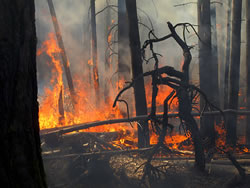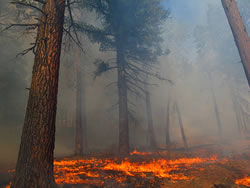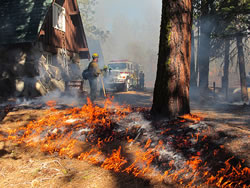National Cohesive Wildland Fire Management Strategy Success Story
Lassen Volcanic National Park Completes Successful Summertown Prescribed Fire
Lassen Volcanic National Park, California
Cohesive Strategy - Fire Adapted Human Communities
2011

Firefighters ignite prescribed burn near the Discovery Center. Photo credit Calvin Farris.

Low intensity fire near the Discovery Center in the Summertown prescribed fire. Photo credit Calvin Farris.

Hazardous fuels removal successful while burning in a Lodgepole jackpot. Photo credit Calvin Farris.

Excellent fire behavior and effects in the ponderosa pine stands occurring in the Summertown prescribed fire. Photo credit Calvin Farris.
Lassen Volcanic National Park fire management staff completed the Summertown prescribed burn project treating approximately 360 acres on October 27-28, 2011. Assistance was provided by personnel from Whiskeytown National Recreation Area, Lava Beds National Monument, Lassen National Forest and the network fire ecologist.
This project lies in the northwest corner of the park adjacent to the developed areas of Manzanita Lake. The unit is bounded to the north by the Nobles Immigrant Trail, to the east by the chaos jumbles, to the south by the park road and to the west by hand line connecting the main park road to the service road that bisects the unit. The area was last burned in June, 2004. The project will provide fire protection for the Discovery Center, adjacent maintenance buildings, the north entrance station and adjacent fee structure.
The Summertown prescribed fire provides for fire ecology and restoration. Other goals for the project were to restore the natural fire regime, improve wildlife habitat, and reduce unnatural fuel loading that contributes to greater risk of high intensity and high severity fire. Other general goals include providing for public and firefighter safety and keeping fire within identified containment lines.
On October 27, 2011 at 11:45 a.m., the test burn was ignited at the northeast corner with smoke heading west. As the afternoon progressed the smoke began heading south toward Lassen Peak. At 5:15 p.m. ignitions were stopped with objectives being met on 150 acres.
Throughout the day, rates of spread remained relatively low except on slope/wind alignment, which was rare. As the fire was backing down a slope, flame lengths were two to four inches. Where there was continuous needle cast under shrubs flame lengths were one to three feet. Overnight there were no smoke impacts to the adjacent communities of Shingletown and Old Station.
On October 28th the test burn was ignited and deemed successful. Ignitions continued in the interior horseshoe and slowly around all of the maintenance buildings. At 3:40 p.m. ignitions ended with a two day total of 360 acres.
Overall the Summertown understory burn was a success, meeting most of the resource objectives. Firefighter and public safety were provided for and no injuries were reported. Fire was kept within identified containment lines and project boundaries.
All resource objectives were met: all park developments and natural/cultural resources were protected and mortality of trees in all size classes was kept at acceptable levels. The needle cast, leaf litter and fine woody consumption reached 80-90%; the primary area where objectives were not met was in the consumption of 100-1000 hour fuels. The goal was for at least 20% consumption while only 10-15% was achieved. This was most likely due to a late snow year and the one foot of snow the area received on October 4th.
Smoke production was minimal due to the light fuel loads and dispersed well on both days to minimize any impacts to Shingletown, Old Station, Highway 44 and the park road. A proactive communication strategy was implemented to inform park employees, the public and the surrounding communities. Information flyers, sign boards and phone calls provided the necessary timely information to educate everyone and encourage their support.
Contact
Scott Isaacson
Email: scott_isaacson@nps.gov
Phone: (530) 595-6163
Keywords: Protect Wildland Urban Interface, Fire Ecology and Restoration